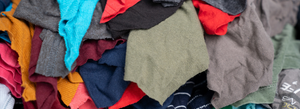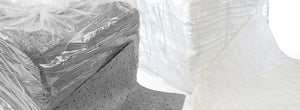Five Benefits of Using Recycled Wiping Rags

Today’s consumers have hundreds of choices when they need wiping rags for their business or industry.
The first choice to make is whether to buy rags made from new material or rags made from salvaged, or previously used, textiles.
Recycled wiping rags — also known as reclaimed wiping rags — have several benefits.
Here are our top five reasons to choose recycled rags:
1 .You Save Money When You Use Recycled Rags
Recycled wiping rags are always less expensive than wiping rags made from never-before-used textiles. The reason for the savings is simple: Just like a used car or a used household appliance, it’s cheaper to buy rags made from reclaimed textiles instead of relying on brand new material.
But unlike a used car or a used appliance, there’s no need to sacrifice consistency of performance when you save money with reclaimed textiles. Whether the source material comes from reclaimed white T-shirts, sweatshirts, corduroy, denim, or flannel, shoppers can still expect consistency when they buy recycled wiping rags.
2. You Get More Absorbency with Recycled Rags
Recycled wiping rags are more absorbent than their new counterparts. In their previous lives as clothing or household textiles, recycled wiping rags were likely washed many times. Washing fabrics makes them soft and absorbent.
Think about how that favorite cotton T-shirt has softened over the years. It will absorb a droplet of water instantly. That same droplet would roll off a new T-shirt.
And, there is significantly less risk of color bleed when using recycled wiping rags with solvents and chemicals when compared with rags made from new material.
3. Using Recycled Rags Reduces Landfill Waste
Reclaimed wiping rags are cost-effective. For many consumers, that’s reason enough to choose recycled wiping rags over rags made from new materials.
But choosing reclaimed rags has another benefit: reducing the waste in our landfills.
According to the Council for Textile Recycling, 85 percent of post-consumer textile waste ends up in our landfills. And, the average citizen throws away 70 to 80 pounds of textile waste annually, accounting for about 15 million pounds of textile waste.
Buying recycled wiping rags isn’t going to solve all the world’s ecological problems overnight, but even our little choices can help Mother Nature.
4. Using Recycled Rags Reduces Carbon Emissions
Modern textiles are durable, which is great for consumers. But once modern textiles enter a landfill, this durability has a downside. As textiles decompose, they emit carbon. And today’s textiles can survive centuries in a landfill before they decompose completely.
According to Textile Recycling Facts and Figures, “the annual environmental impact of a household’s clothing is equivalent to the water needed to fill 1,000 bathtubs and the carbon emissions from driving an average modern car for 6,000 miles.”
Choosing reclaimed wiping rags gives old sweatshirts, denim, and even colored T-shirts a new life, keeping them out of landfills.
5. Recycled Rags Create Jobs
Reclaiming textiles for use as wiping rags is labor intensive, employing thousands of workers in the United States. Workers sort and cut used clothing and textiles into wiping rags. Each garment is handled, processed, and inspected by a human employee.
Compare that to today’s textile industry which relies more and more on automation and outsourcing, and recycled wiping rags make even more sense economically.
Reclaimed Wiping Rags FAQs
What are recycled rags used for?
Recycled wiping rags can be used for cleaning up any kind of mess, whether at work or in the home. Recycled rags perform consistently since the fabric has typically been washed and re-washed multiple times in its former life as a sweatshirt or T-shirt.
Can oily rags be recycled?
Unless a material has been exposed to hazardous or flammable materials, it can be cleaned and recycled. Recycled rags made from reclaimed textiles usually come from T-shirts, flannel, or denim, and workers sort out unsuitable materials.
What is the best material for rags?
Cotton performs well and remains durable despite multiple uses. Reclaimed white T-shirts are often made of cotton with high thread counts, making them versatile as reclaimed wiping rags. Microfiber rags made from new materials work well for removing stains and polishing wood, vinyl, chrome, and glass.
Are recycled rags really clean?
Yes, they’ve been previously used as T-shirts, towels, or jeans. But they’ve also been previously washed before they’re cut into rags. While reclaimed wiping rags are cleaned and ready for use when they arrive at your home or business, they don’t always look pretty. Shoppers who need matching patterns and colors should buy rags made from new materials.
Try Recycled Wiping Rags from All Rags
If you are not currently using recycled wiping rags at home or in your business, we encourage you to try some with your next wiping rag purchase. Keep an open mind, as they don’t always look as pretty or as consistently shaped as new wiping rags.
If the wiping rag’s outward appearance is not important to its function, a recycled rag is clearly the most cost-effective and environmentally friendly choice you can make.
Check out our specials on Recycled Color T-shirt Knit Rags and Recycled Colored Sweatshirt Rags and call us today at 1.888.335.6439 or order online to start benefiting from using recycled wiping rags.
- Brad Grossman







